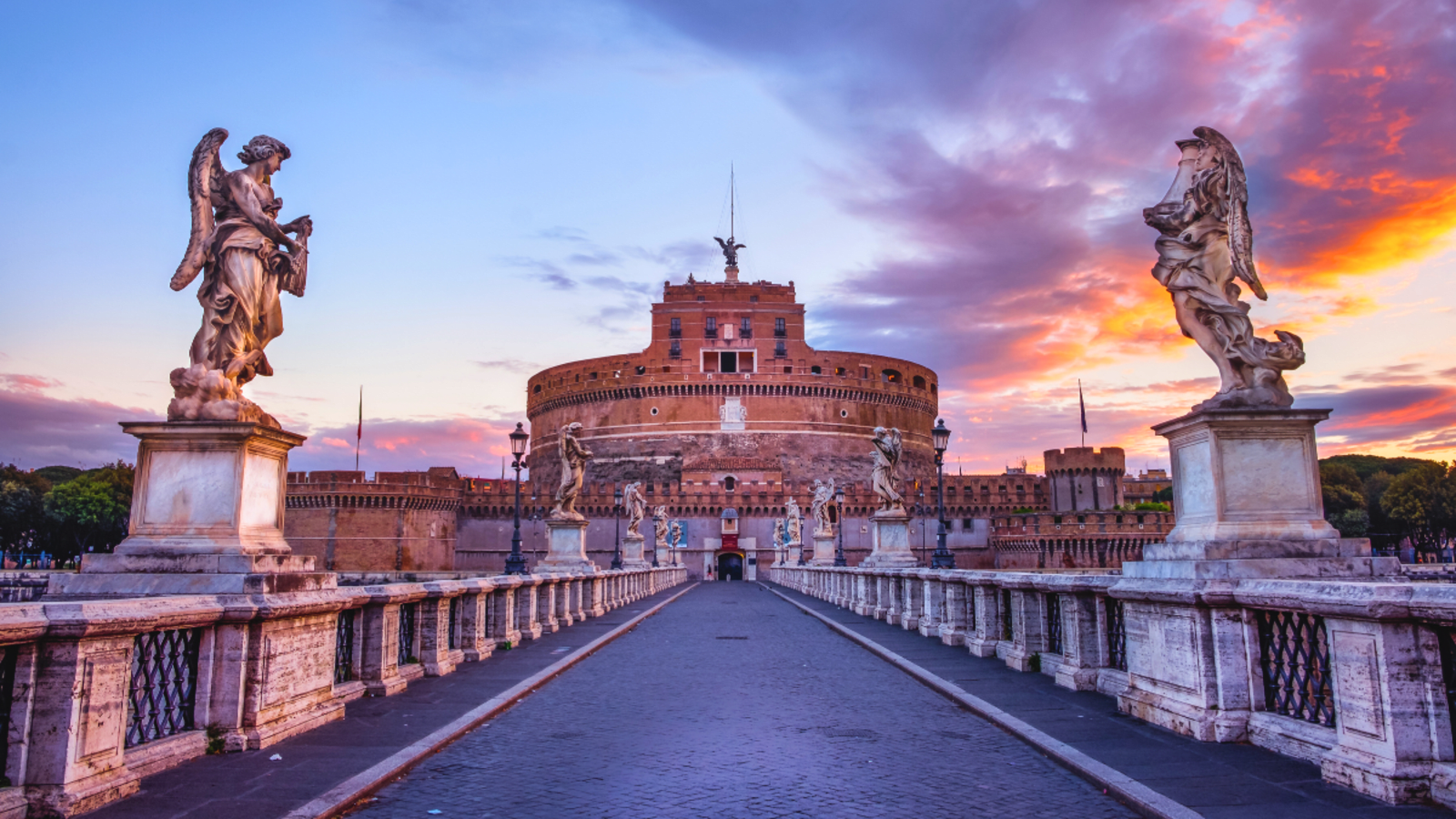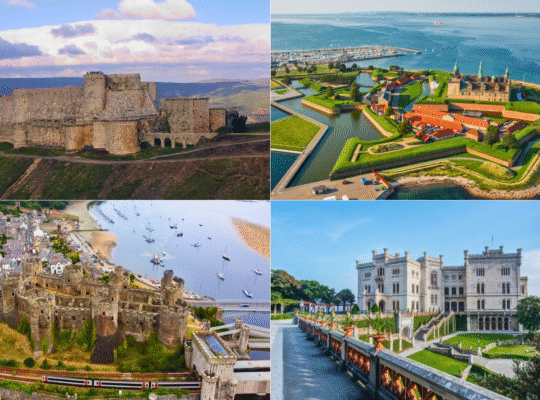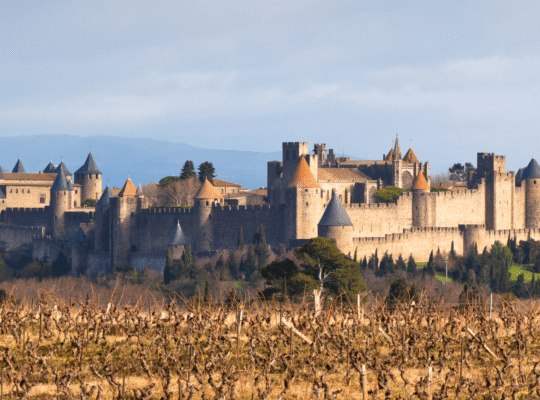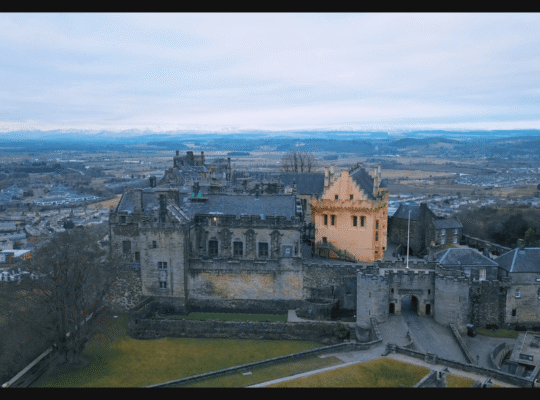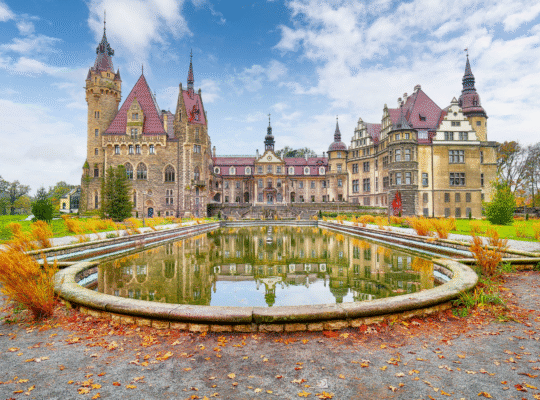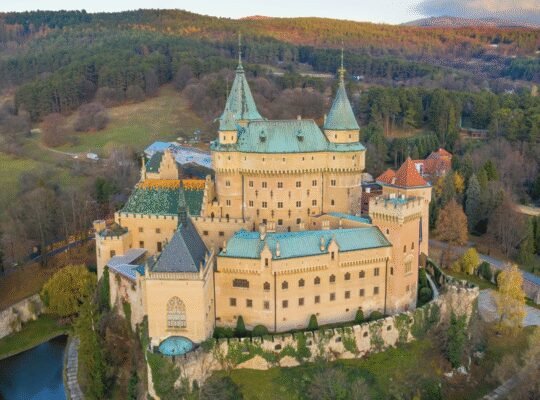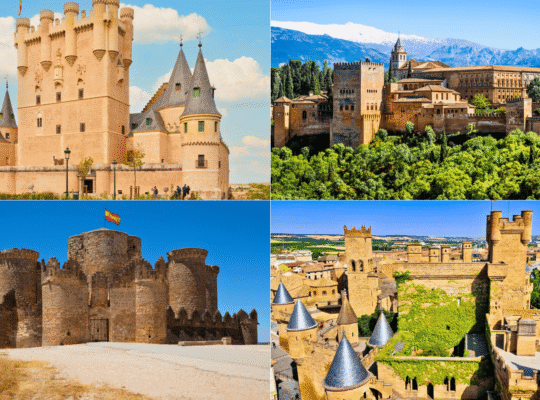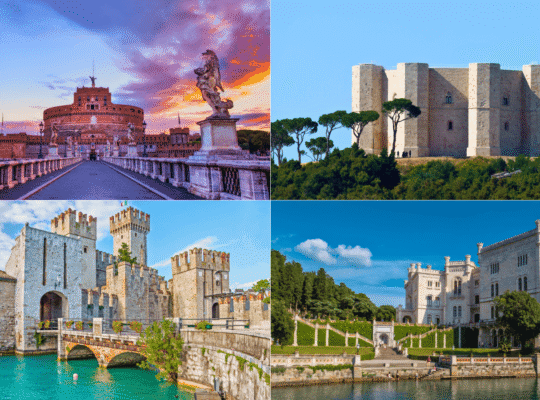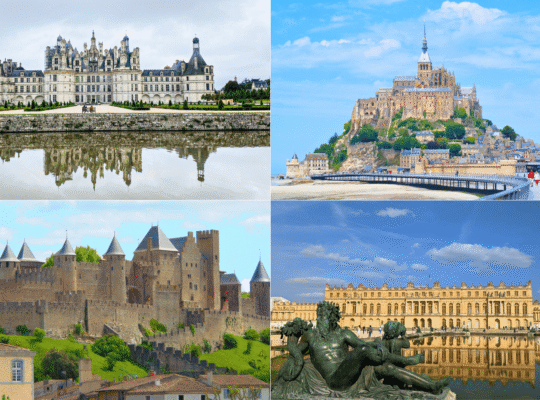I’ll never forget the first time I saw Castel Sant’Angelo—not because it’s the most beautiful building in Rome (it isn’t), but because it stopped me dead on my tracks while I was hurrying to catch the sunset from the Vatican steps. Rome is full of old stones and “must-sees,” but nothing prepares you for this hulking round fortress, standing stubborn and silent on the edge of the Tiber, like it’s been waiting for you all along.
The approach isn’t grand, but it is unforgettable: You dodge Vespas and street artists, wander past gelato shops with sticky-fingered kids, and suddenly the city noise softens. The golden light bounces off the angel-topped ramparts, and you catch the scent of river water, warm stone, and roasting chestnuts from a cart nearby. If you’re lucky, a saxophonist is playing under the Ponte Sant’Angelo, the notes spiraling up toward the angel statues that guard your path like something out of a Dan Brown novel.
Here’s a secret: most locals hardly give Castel Sant’Angelo a second glance. For them, it’s the backdrop for joggers, first dates, and late-night river walks. But to a traveler, especially if you let your imagination run wild, it’s a place where all of Rome’s tangled stories come together—empires, popes, plagues, exiles, and the odd scandal or two.
Some call it Rome’s “forgotten castle.” Don’t believe them. Castel Sant’Angelo is where you go to see the city’s past stacked up like old coins: Emperor Hadrian’s last wish at the bottom, a Renaissance papal penthouse at the top, and centuries of secrets in between. It’s not just a castle. It’s Rome’s most surprising survivor—and if you’re anything like me, you’ll walk away with at least one great story of your own.

Quick Facts: Castel Sant’Angelo at a Glance
📍 Location: Lungotevere Castello, Parione, Rome, Italy
🏗️ Construction Period: 135–139 AD (Roman Imperial origin); major transformations: medieval (5th–14th centuries), Renaissance (15th–16th centuries)
🏰 Architectural Style: Roman Imperial, Medieval Fortress, Renaissance Palace
🎭 Famous For: Mausoleum of Hadrian, papal fortress, secret escape passage (Passetto di Borgo), panoramic rooftop views, legendary hauntings
👑 Notable Figures: Emperor Hadrian (founder), Popes (especially Clement VII, Alexander VI), Benvenuto Cellini, Beatrice Cenci
🏆 UNESCO Status: Yes (Part of the Historic Centre of Rome, listed 1980)
🌐 Official Website: https://castelsantangelorome.com/

History & Legends
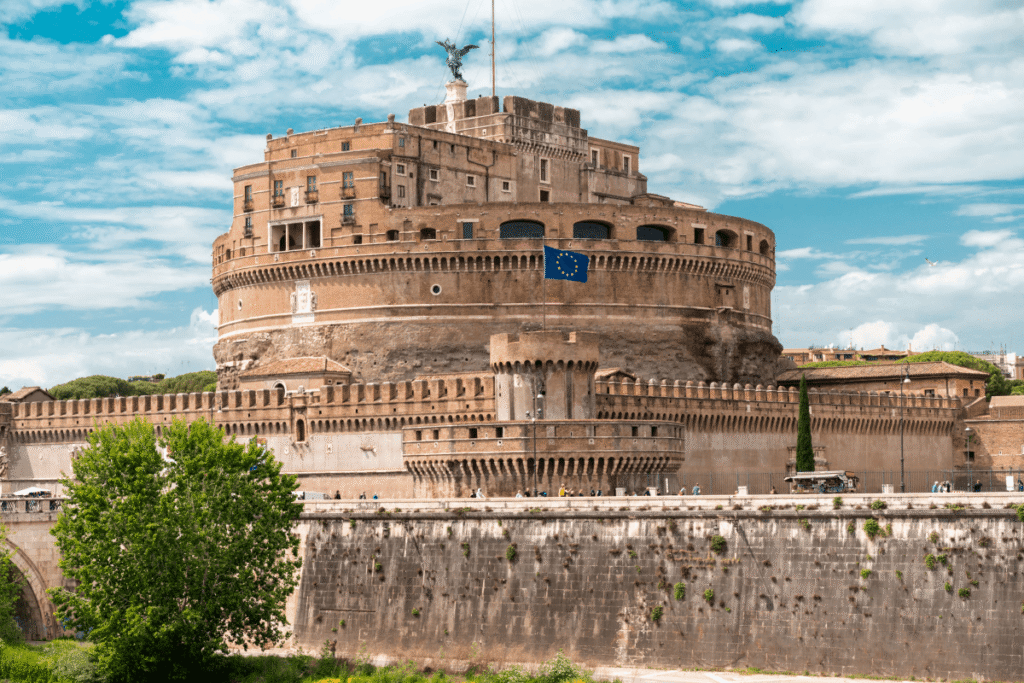
Rewind nearly two millennia. Castel Sant’Angelo didn’t begin as a castle. It was conceived as a tomb. Emperor Hadrian—the Hadrian of Britain’s Hadrian’s Wall fame—wanted a resting place that would be eternal. The choice of location, on the banks of the Tiber River, was his. He commissioned a circular mausoleum to be built, covered with gleaming white marble, topped with a golden statue of Hadrian himself in a chariot pulled by four galloping horses. Hadrian’s successors, who also reigned as Roman Emperors for a time, shared the expectation that they would live on forever in the public consciousness.
Ah, but Rome is a city that cannibalizes its past. By the 5th century CE, when invaders were battering the old empire, Hadrian’s mausoleum was converted into a military aid station. Marble was pillaged, and golden statues were melted down for coins. Popes of Rome built ramparts and towers to fortify the tomb against the next emergency. The apocryphal story that endures with most Romans is that in 590 AD, during a particularly vicious outbreak of plague, Pope Gregory the Great (S. Gregorio Magno) prayed in front of the mausoleum and saw the Archangel Michael on horseback sheathing his sword at the top of the tower, signifying the end of the epidemic. The mausoleum of Hadrian, from that moment on, became known as “Castel Sant’Angelo”—the Castle of the Holy Angel.
Rome’s long medieval and Renaissance periods saw the castle undergo further changes in form. In 1527, during a siege of the city, Pope Clement VII bolted down a secret raised walkway, the Passetto di Borgo, that runs from the Vatican (along the Tiber, and right next to Castel Sant’Angelo) to the battlements of the castle. (If you envision robe-wearing cardinals sprinting back and forth at night, you are getting close.) Popes used Castel Sant’Angelo as a fortified refuge: part stronghold, part safe house, part panic room, only with frescos and gold ceilings.
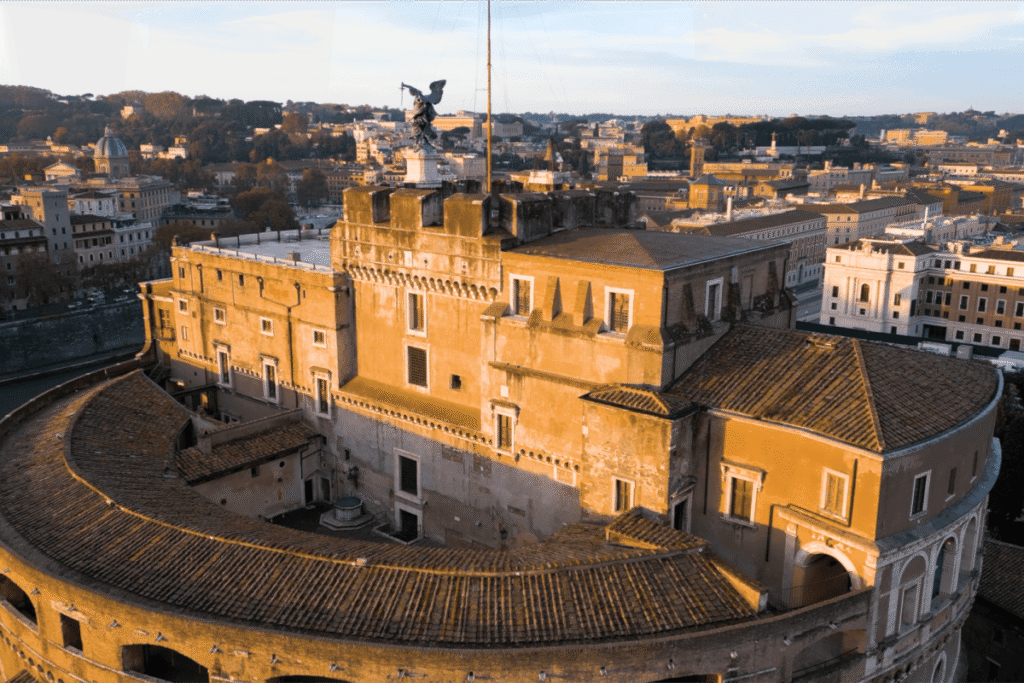
Over the centuries, the castle also became a prison, and cellblocks were populated with plotting aristocrats, dissident artists (Benvenuto Cellini, the famous goldsmith, spent time there), and, of course, tragic souls like Beatrice Cenci, whose ghost is said to roam the battlements after she was beheaded. Romans are never shy about a good haunting story. On a crisp autumn night, you’ll hear reports of ghosts moving through the ancient halls, flickering lights, and strange whispers emanating from deep within the walls.
Castel Sant’Angelo is now a museum, and all the layers of its long, shape-shifting history are visible and tangible to the visitor. Wander the halls and every stone seems to contain a rumor, a hidden treasure, a papal escape, a night of wild debauchery, and a feast gone spectacularly wrong. This is a castle that does not easily recede into the background of a city’s historical panorama. It has played a hand in Rome’s grandest history and its pettiest scandals, and no small part of the fun is in discerning the rumors from the truth.

Architecture & Design
You’ll notice it before you even cross the bridge—the way Castel Sant’Angelo doesn’t look quite like anything else in Rome. There’s no fairy-tale turret, no delicate Renaissance spire. Instead, it rises up in thick, stubborn circles, solid and unpretentious, like a giant drum that’s dug in for the long haul. Hadrian’s bones may be gone, but the bones of the building are still right there for you to see.
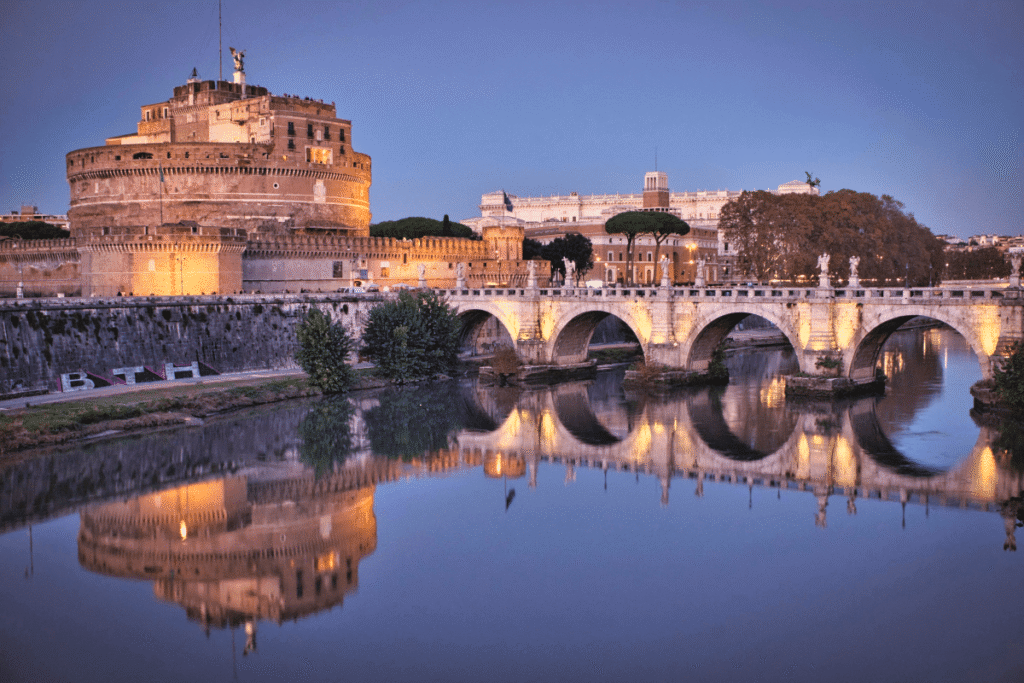
Start at the Ponte Sant’Angelo. Five angels line your approach, carved in marble, each holding a symbol of Christ’s Passion. On a humid summer evening, you’ll find locals leaning on the railings, teenagers playing guitar, and maybe a few buskers hoping the echo of their music bounces all the way to the Vatican. Look up: the bronze angel on the rooftop seems to keep watch over the city’s tangled history and late-night wanderers.
Inside, the place is a maze—ramps spiraling up, tight stairways, courtyards that catch slivers of sunlight, and unexpected bursts of art tucked into shadowy corners. You’ll pass through layers of history with every step: ancient Roman stonework gives way to medieval arches, which in turn open onto rooms plastered with Renaissance frescoes and bold, baroque details. The effect is strange but electric, as if someone shuffled a deck of centuries and let you wander through the hand.
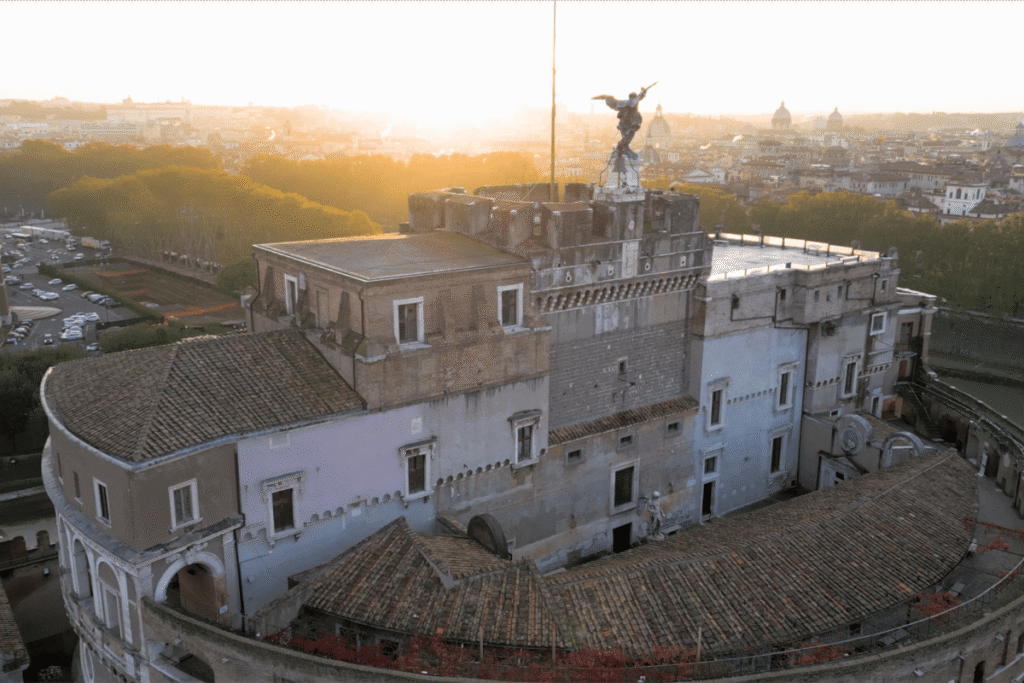
There’s a spiral ramp, wide enough for a chariot—no joke, that was the original idea—leading you up through the heart of the fortress. Along the way, you might stumble across an old cannon, a pile of rusty armor, or a faded fresco of some pope who once hid out here. The papal apartments are a surprise: lavish, yes, but also oddly cozy. The walls are covered in intricate frescoes, golden ceilings gleam in the dim light, and in the windows, you’ll catch slices of the Tiber or a sudden glimpse of St. Peter’s dome.
Up on the ramparts, the mood shifts. The city buzz fades, replaced by a hush broken only by pigeons and the occasional gust of wind. From the rooftop terrace, Rome sprawls out in every direction—domes and bell towers, rooftop gardens, the glint of the river below. Stay a while. Let your eyes trace the curve of the ancient walls, or try to spot the Passetto di Borgo—the secret corridor that links the castle to the Vatican. Some say you can feel the old stones humming with the stories of popes, prisoners, and soldiers who paced here before you.
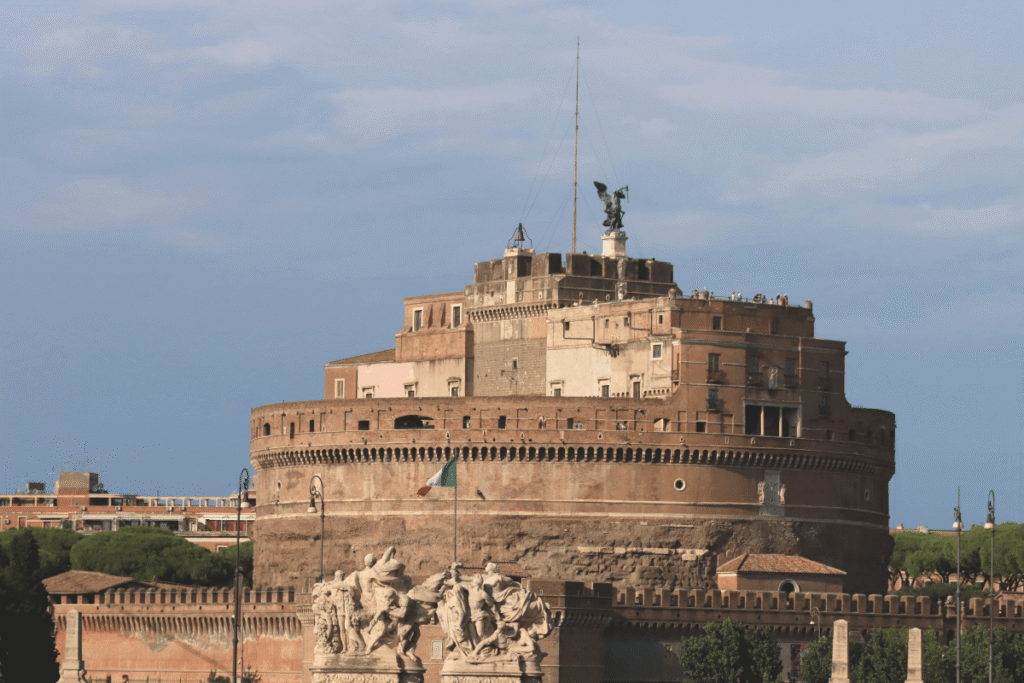
This isn’t a castle that tries to charm you with romance. Instead, it lets you touch Rome’s rough edges, wander through a tangle of centuries, and stand—just for a moment—at the crossroads of empire, faith, and raw survival. And if you listen closely, especially on a quiet morning, you might just hear the city’s heartbeat echoing through the walls.

Visiting the Castle (with real-life tips)
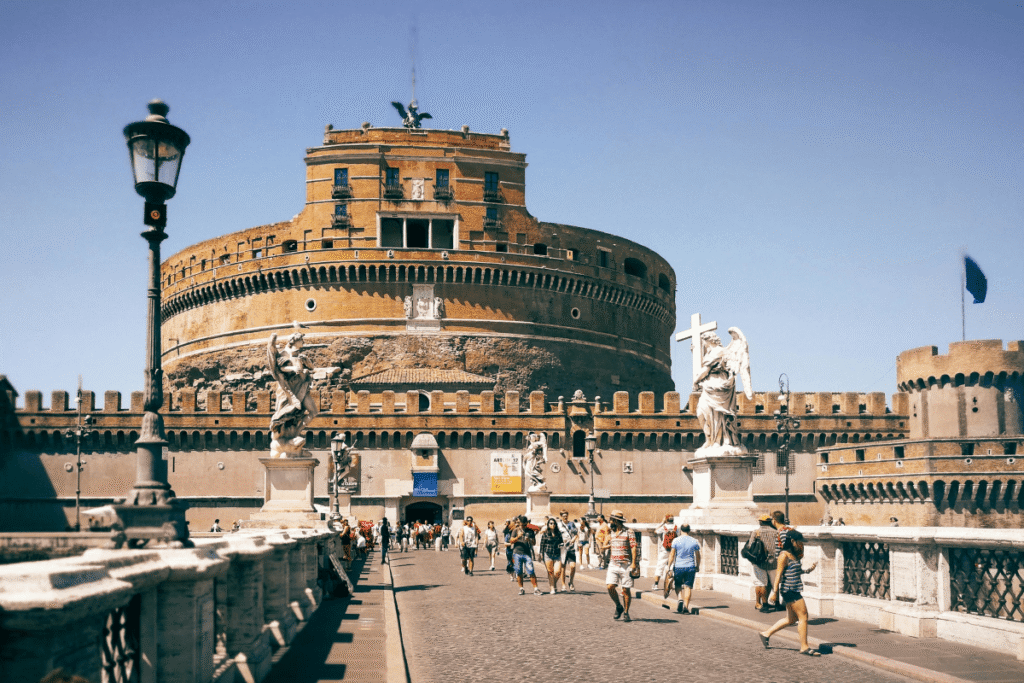
🛣 How to Get There
It’s hard to get lost in Rome, but if you do, Castel Sant’Angelo is an easy landmark. From most points in central Rome, the castle is visible, perched on the riverbank just a ten-minute stroll from St Peter’s Square and fifteen minutes from Piazza Navona. The nearest metro station is Lepanto (Line A); from there it’s a relaxing fifteen-minute walk (flanked by gelato shops, café tables, and herds of vespas). Buses drop you off at Lungotevere or Piazza Pia, but otherwise you’re better off on foot: there’s rarely a dull moment on Rome’s streets, so why not experience them? For the more energetic, the Ponte Sant’Angelo is also a fine approach: the bridge is part of the attraction, with baroque angels and your first close encounter with street performers clamoring for photos. Driving is best left to Romans (or insane out-of-towners with a divine parking instinct).
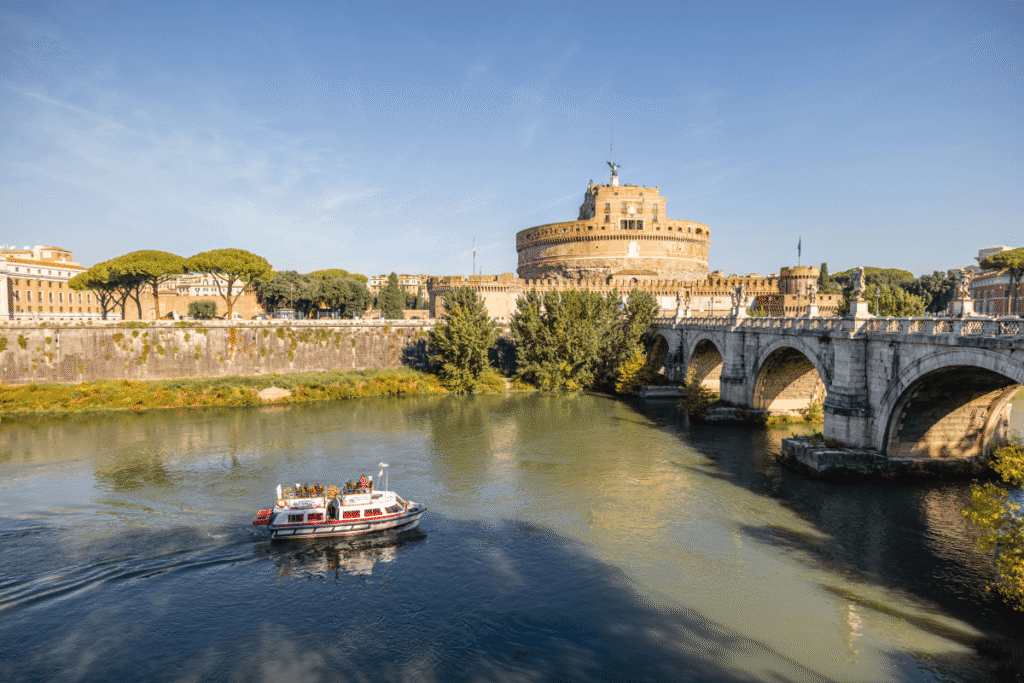
🎟 Entry & Tours
Ticket prices to Castel Sant’Angelo typically start at around €16 for adults (discounts for EU citizens under 25 and free for children under 18). Always check the official website for temporary exhibitions and actual prices before your visit. The castle is open from 9:00 AM until 7:30 PM (last entry at 6:00 PM), though holiday hours are a little shorter. Tickets are sold at the door, but lines are always long, especially in the summer and on weekends—online booking is recommended. Guided tours (available in English and Italian) are a great option if you like to go deep (literally). Guides have access to restricted areas and top secret (yet 100% documented) histories, and take you through hidden nooks and crannies and up to the rooftop terrace, as well as through the famous Passetto di Borgo (secret walkway to the Vatican) on select days. If you don’t want to go on a tour, self-guided audio guides are a surprisingly fun option, for a small additional fee. An ID is required if you’re claiming a discount.
⏰ Best Time to Visit
The best times to visit Rome are during the shoulder seasons, late spring through early fall: think outside the crowds and inside the castle. Walk right through the gate when the doors open, or wander late in the afternoon (golden hour on the rooftop terrace is magical). In winter, the weather is a dice roll, but the serenity in the halls makes up for the chill. Events (summer evening concerts, etc) are a bonus, but also more crowded—book in advance if you’re set on a particular date.
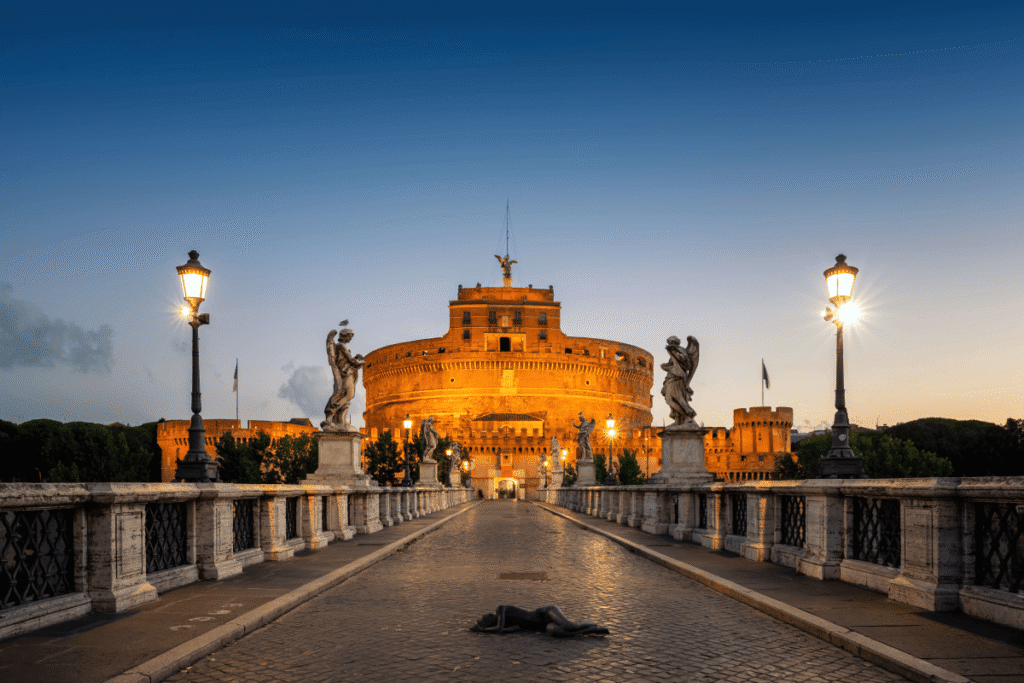
♿ Accessibility & Tips
Castel Sant’Angelo is a medieval fortress, and most areas inside are not designed with modern accessibility in mind. Access to the lower levels and courtyards is possible, but narrow and difficult for visitors with limited mobility. The spiral ramp and upper floors are narrow and steep, and paved with stones that have seen a few millennia more than they should have. There is a lift, but limited access—ask at the entrance or check in advance. Strollers are not recommended (deposit at the ticket desk, if you can). Families: while kids are entranced by the armory and the rooftop, this is not a great trip for young toddlers, and caution is advised near the parapets. Parts of the castle can be drafty even in the summer, so pack a light layer just in case. Water bottles are permitted, but must be emptied before entry and refilled at the fountains inside.
The castle café is a good option for refreshment and a break: decent coffee and panini, with a killer view from its terrace. Prices are on the high side, but you do get a free photo op. If you’d prefer to stretch your legs and head for something more filling, the neighbourhood Borgo Pio has trattorias and gelaterias with a less touristy (read: pricier) bent.
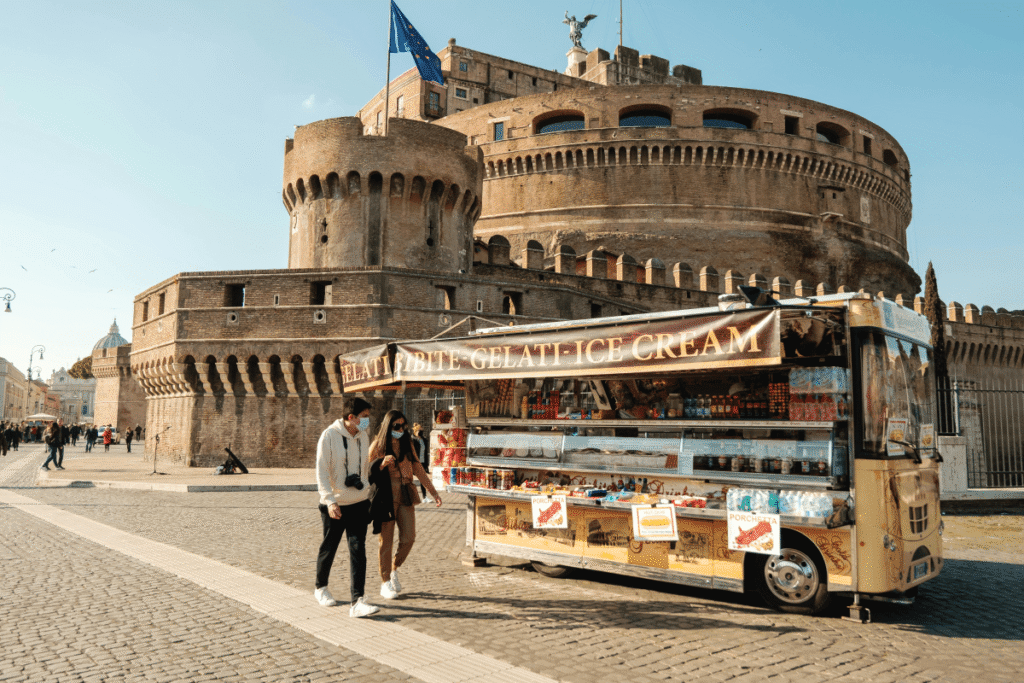
Personal note: if you get lost, don’t panic. Follow the crowds of school kids (I’ve never yet met a child scared of Castel Sant’Angelo) or the echo of excited voices bouncing off the ancient walls. Rome is easy to walk around, and don’t forget to just wander and poke your head into strange nooks and crannies; it’s half the fun. After all, you’re not here for a race, you’re walking on two millennia of history.

What to See Nearby
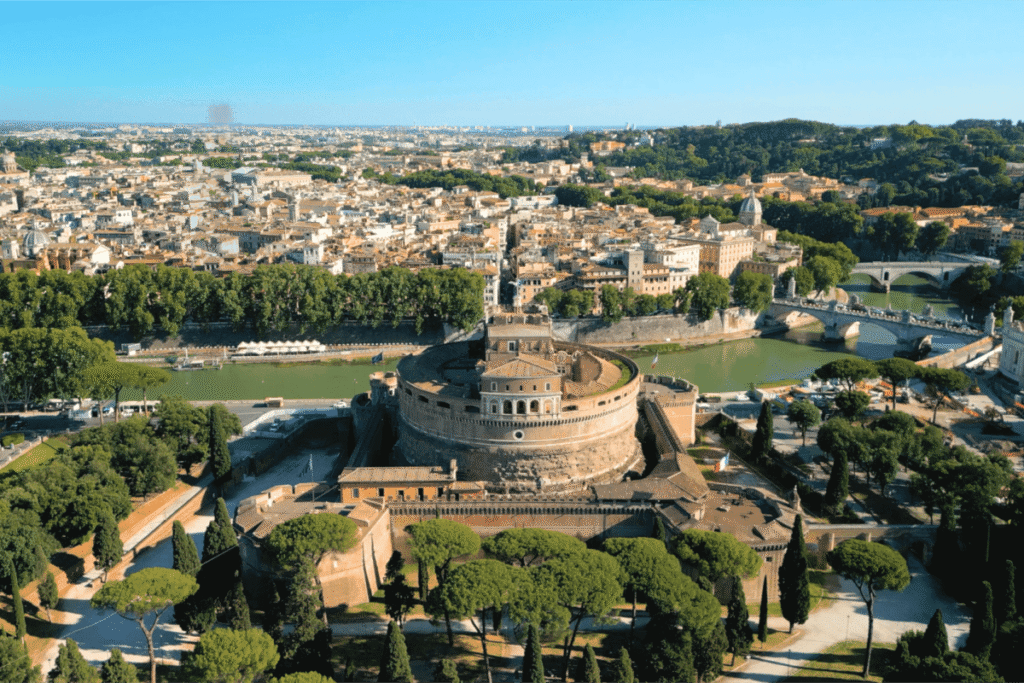
Castel Sant’Angelo is right in the center of Rome, so you can’t really go wrong when choosing other nearby sights and neighborhood haunts. A few of our favorites within walking distance:
St. Peter’s Basilica & Vatican City
St. Peter’s Basilica is visible on the horizon, just ten minutes west. It appears to loom over you when viewed from the castle’s terrace across the river. Inside, if you have time (and the energy to wait in security lines), you’ll find the world’s most famous church and Michelangelo’s Pietà. The Vatican Museums and Sistine Chapel are just beyond, but be sure to buy tickets in advance.
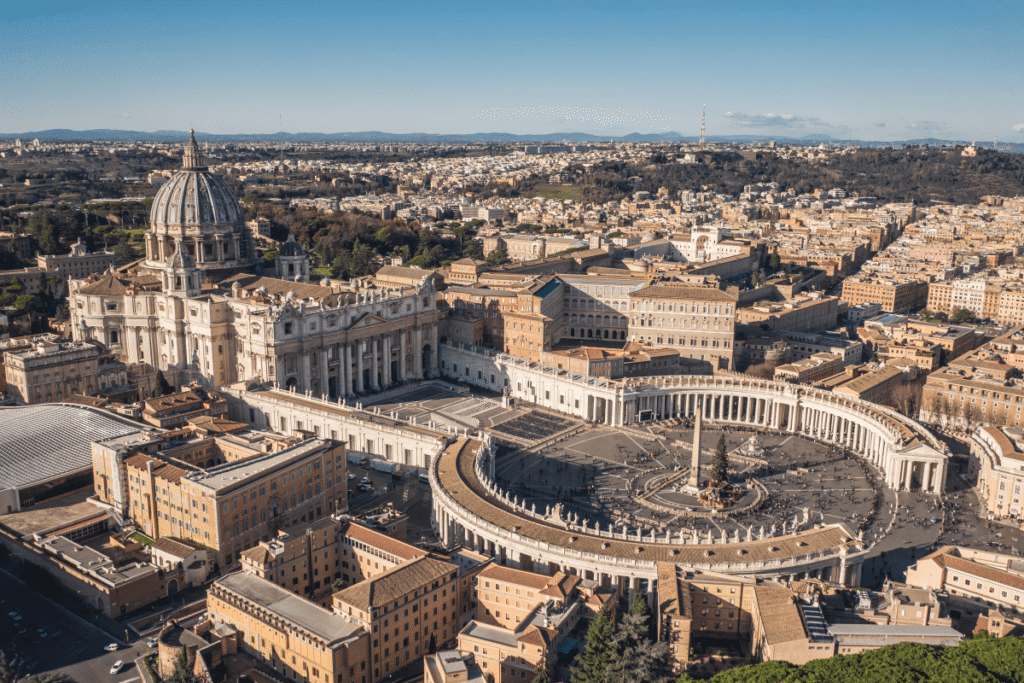
Ponte Sant’Angelo
Although you will have crossed it to get to the castle, be sure not to skip the bridge itself, a line of Bernini-designed angels that line the crossing like a set piece out of a play as much as an architectural marvel. Best visited at sunrise or after dark, when the tourists have gone home and the river sparkles with lamp-light.
Piazza Navona
A fifteen-minute walk southeast, Piazza Navona is packed with street painters, fountains, and the occasional musician struggling to be heard above the others. A must-do is to find a table at a café (pricey, but worth it), and people-watch the world go by. The baroque fountains in the middle of the square, especially Bernini’s Fontana dei Quattro Fiumi, are showstoppers.
Borgo Pio
Hidden behind the castle and Vatican, a narrow side street with old-school Roman trattorias, bakeries, and local shops, perfect for a lunch, people-watching, or gelato away from the main tourist hordes.
Trastevere
Cross the Tiber and follow the signs south into Trastevere, a neighborhood of winding cobbled streets, ivy-draped houses, and laid-back late-night wine bars where you’ll find Rome at its most relaxed. It’s a bit of a walk (twenty-five minutes on foot), but well worth it for dinner and a slow stroll back across the river under the stars.
Photo Bonus Side Note
Our little secret photo-op: if you walk to the far bank of the Tiber and look back at the castle and bridge, you’ll get a classic “postcard Rome” shot, especially at sunset.

Castel Sant’Angelo FAQ
How much time should I plan for a visit?
Plan for 1.5 to 2 hours if you want to see the main highlights, but you could easily linger half a day if you take a tour, climb to the roof, and enjoy the café view.
Can I buy tickets on the day of my visit?
Yes, but lines can be long—especially on weekends and in summer. Book online to save time and guarantee your slot, especially during peak months or for special events.
Is Castel Sant’Angelo family-friendly?
Absolutely. Kids love the ramparts, cannons, secret passages, and rooftop views. Just keep an eye on little ones near stairways and parapets—there are steep drops in places.
Is the castle accessible to visitors with limited mobility?
Partly. The main courtyard and lower levels are accessible, and there is a lift, but some areas (especially upper floors and the spiral ramp) are challenging. Call ahead for the latest on accessibility options.
Can I take photos inside?
Definitely! Photography is allowed almost everywhere, but tripods and flash may be restricted in some rooms. The rooftop terrace offers some of the best panoramas in Rome.
Is there a dress code?
No dress code, but wear comfortable shoes—those ancient stones are rough on sandals and high heels. A light layer is smart for breezy rooftop moments.
Can I bring food and drinks?
You can bring water bottles (empty at security, refill inside), but food isn’t allowed inside the exhibits. The café has light snacks and drinks, plus a great terrace.
Are there guided tours in English?
Yes—guided tours are available in English and Italian, often including access to the secret passage to the Vatican. Check the official website for schedules and booking.
Is the castle haunted?
Ask a Roman and you’ll hear all sorts of ghost stories—from Beatrice Cenci on the ramparts to echoes of old prisoners. Is it haunted? Who knows—but the atmosphere after dark is hard to forget.
What’s one thing I shouldn’t miss?
Don’t skip the rooftop terrace. The view at sunset—city domes, river, and angel watching over you—might just be the memory that sticks.
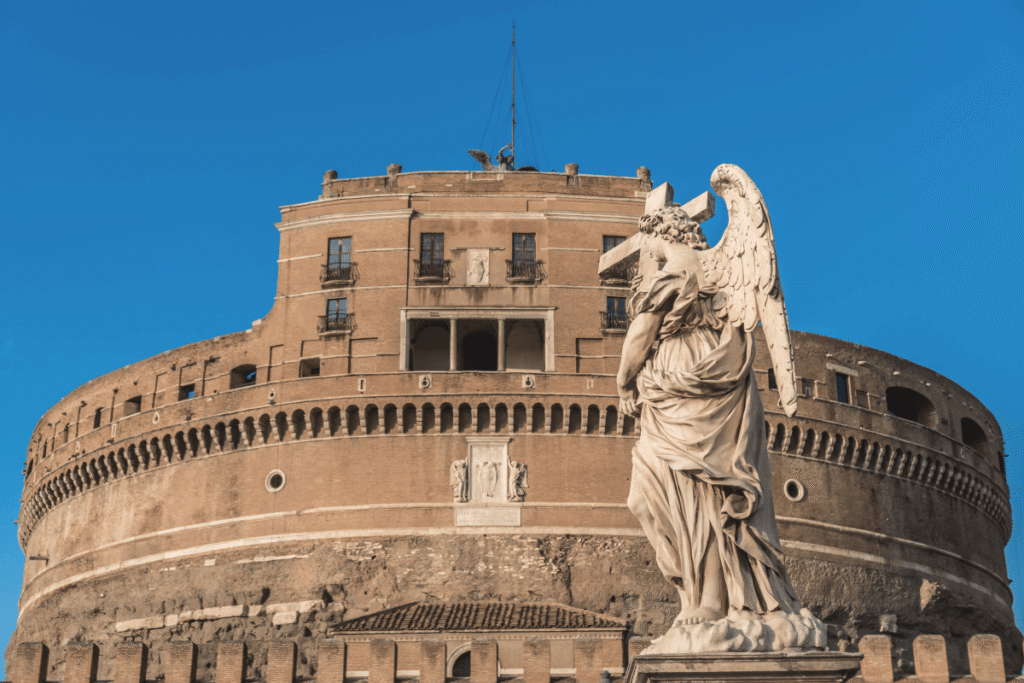

Final Thoughts
Castel Sant’Angelo is one of those places that follows you. It’s not Rome’s most beautiful monument, nor does it pretend to be. Instead, it’s obstinate, unforgettable, and a little moving. It’s a place where centuries congregate underfoot, and you visit for the rooftop but leave with fragments of stories: of emperors that desired immortality, popes that sought refuge, and ghosts that remain tethered.
If you time it right, you might even find yourself there during golden hour when the city is somehow softer. The shadows are long on the river. The angel above the castle is aglow, like a signal. Stand there, just for a minute. Watch the city churn and still. It’s a secret locals won’t tell you. But there’s always room for another silent observer.
💬 Have you been to Castel Sant’Angelo? Share your rooftop experience below! Was there a secret spot you discovered, a piece of trivia you couldn’t get out of your head, or a travel blunder you had to laugh at? Tell us all about it! We’d love to read your story in the comments below. Or tag us on Instagram @CastleQuestChronicles!
👉 Also, don’t miss our post on The 10 Best Castles to Visit in Italy and the ultimate guide to The Best Castles in Europe for more Italy travel inspiration!
Castles don’t get more down-to-earth than this one. Go see for yourself, and come back to let us know what you think!
🏰✨ If this article sparked your curiosity about the castles, follow along. We are on Instagram, Pinterest, Facebook, and X, too. Also, you can explore all our castle adventures here! More castles (and more stories) are just around the bend.

